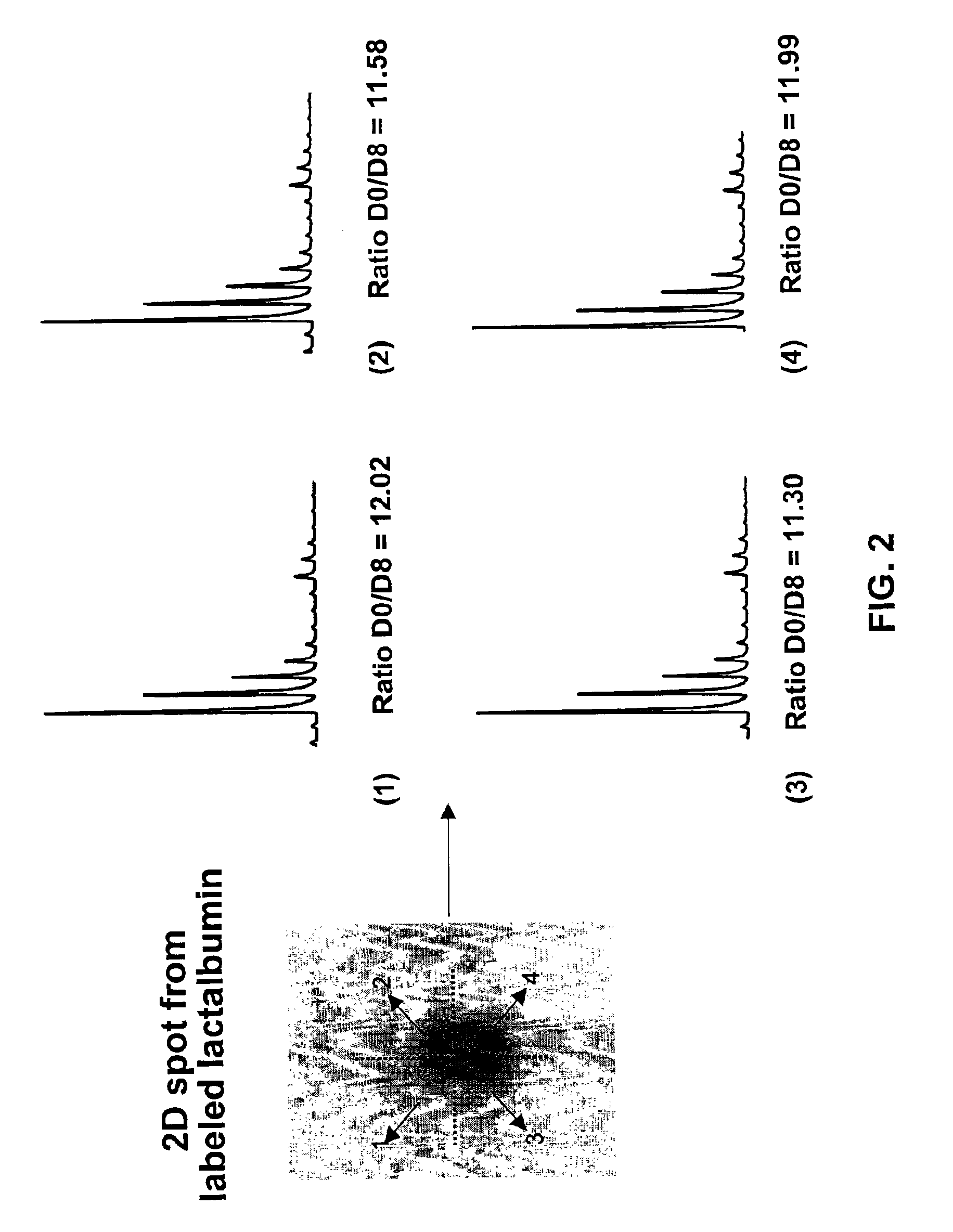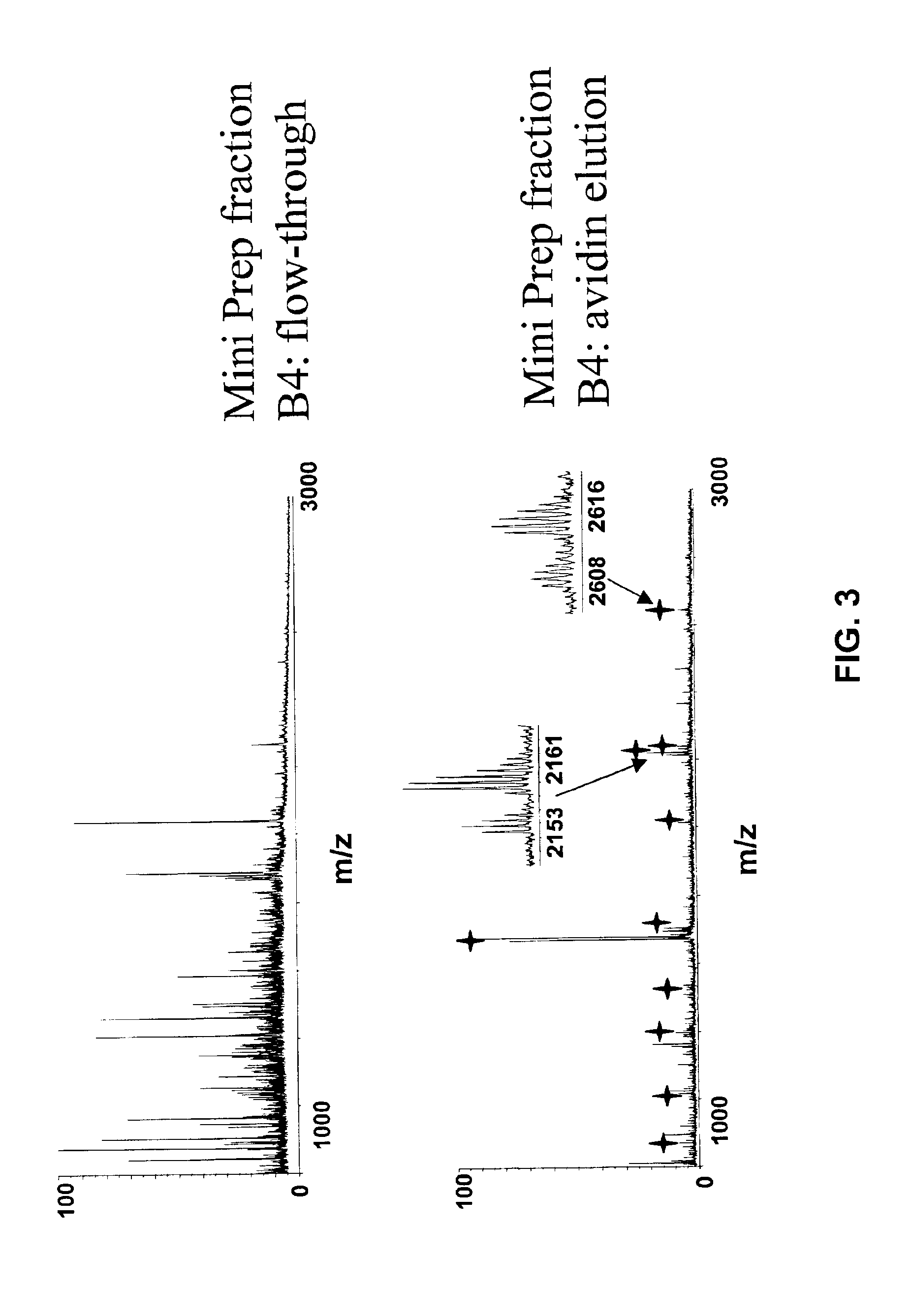Process for analyzing protein samples
a protein and sample technology, applied in the field of protein sample analysis, can solve the problems of limiting the amount of information that can be obtained by such analyses, unable to meet the throughput and automation of presently available genomic technology, and no protein analytical technology can achieve the level of automation and throughput of presently available genomic technology, and achieve the effects of reducing disulfide bonds, facilitating labeling, and facilitating digestion on the membran
- Summary
- Abstract
- Description
- Claims
- Application Information
AI Technical Summary
Benefits of technology
Problems solved by technology
Method used
Image
Examples
example 1
[0088]Five different standard proteins were alkylated separately with the d0 ICAT reagent and the d8 ICAT reagent, and mixed together in different ratios prior to performing 2D gel electrophoresis. After staining, the spots corresponding to these proteins were cut out, digested with trypsin, and submitted to PMF. FIG. 1 shows an image of the gel and insets of each mass spectrum that contain one of the ICAT reagent pairs from each protein. In addition, the ratio at which the proteins were mixed together prior to gel electrophoresis is listed, as well as the ratio of d0 to d8 that was obtained by mass spectrometry. In all five cases, the discrepancy between the experimental and the observed ratios was well below 20%.
[0089]One of the problematic aspects of separating ICAT reagent labeled peptides by HPLC is that the d8 labeled peptide typically elutes several seconds ahead of the corresponding d0 labeled peptide. To demonstrate the fact that upon gel electrophoresis there is no similar...
example 2
[0090]E. coli bacteria lysates, either labeled with an ICAT reagent comprising deuterated biotinyl iodoacetamide reagent for minimum medium (glucose) growing condition or labeled with non-deuterated reagent for rich medium (LB broth) growing condition, were mixed at equal amounts. The mixture was separated through a preparative flow-through SDS gel (5%) apparatus (Mini Prep Cell, Bio-Rad) and proteins were fractionated into solution. The fractionated proteins were then acetone precipitated before proteolytic digestion by overnight incubation with trypsin. Upon avidin chromatography, peptides from both the flow-through portion and the elution portion were collected into 96 fractions. The flow-through was captured on reversed phase medium (POROS® 50R1, Applied Biosystems) and washed with distilled water and eluted with 60% ACN. Samples were vacuum dried and re-suspended with 50% ACN / 0.1% TFA. Spectra were acquired using an Applied Biosystems Voyager MALDI TOF mass spectrometer with α-...
example 3
[0094]Two E coli preparations similar to those described above were labeled with ICAT d0 reagent and ICAT d8 reagent, mixed together and submitted to 1D SDS gel analysis. Slices were cut from the gel, washed, digested with trypsin, and the peptides were eluted. No avidin affinity chromatography was performed, so that only the most intense ICAT reagent labeled peptides were detectable. Upon PMF analysis with ChemApplex, E. coli tryptophanase was detectable as the most prominent protein component, after trypsin itself. Under these conditions, the peptides that corresponded to ICAT reagent pairs were also detected in an oxidized form, due to oxidation at the original cysteine sulfur atom, analogous to the oxidation of methionine residues that is commonly observed post SDS gel analysis. Thus, each peptide provides two independent measurements of the ratio of d0 to d8, one for the reduced form of the peptide, and one for the oxidized form of the peptide. A prominent quartet of peaks abou...
PUM
| Property | Measurement | Unit |
|---|---|---|
| Fraction | aaaaa | aaaaa |
| Fraction | aaaaa | aaaaa |
| Fraction | aaaaa | aaaaa |
Abstract
Description
Claims
Application Information
 Login to View More
Login to View More - R&D
- Intellectual Property
- Life Sciences
- Materials
- Tech Scout
- Unparalleled Data Quality
- Higher Quality Content
- 60% Fewer Hallucinations
Browse by: Latest US Patents, China's latest patents, Technical Efficacy Thesaurus, Application Domain, Technology Topic, Popular Technical Reports.
© 2025 PatSnap. All rights reserved.Legal|Privacy policy|Modern Slavery Act Transparency Statement|Sitemap|About US| Contact US: help@patsnap.com



